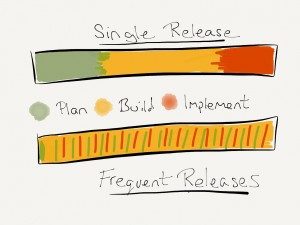This is a final post originally published on the Rally Blog which I am reposting here to keep an archived copy.
 I live in Brighton, on the south coast of the UK, about 50 miles from London. This means that I regularly catch the train for meetings or engagements “in town”. When making the journey, I always look at the timetable. Trains only run every 30-60 minutes, so if I get the timing wrong, then I’m most likely left hanging around at the station. Not a great use of time, especially with the typical British weather. When I get into London and need to catch the tube somewhere, however, it’s a different story. I just head to the right platform and wait for a train, knowing that one should turn up in a few minutes. There’s no need to check the timetable.
I live in Brighton, on the south coast of the UK, about 50 miles from London. This means that I regularly catch the train for meetings or engagements “in town”. When making the journey, I always look at the timetable. Trains only run every 30-60 minutes, so if I get the timing wrong, then I’m most likely left hanging around at the station. Not a great use of time, especially with the typical British weather. When I get into London and need to catch the tube somewhere, however, it’s a different story. I just head to the right platform and wait for a train, knowing that one should turn up in a few minutes. There’s no need to check the timetable.
What does this have to do with Agile? I was recently on a Q&A panel and fielded a question about how to deal with fixed date and scope projects. The story above hints at the answer…
Managing Variables
Before we come to that, let’s first look at the common ‘Iron Triangle’ variables of time, cost and scope. If the date (and hence time) and scope are fixed, then logic suggests that the only thing we can vary is cost. This typically means adding people, although it could mean throwing money at the problem in some other way. Brooks’s Law, “Adding manpower to a late software project makes it later”, says that this will not work. An Agile approach can mean that any problems meeting the date and scope will be discovered earlier, and hence the effect of Brooks’s Law can be minimised. Colleague Alex Pukinskis recently blogged about how the Rally development team cheated Brooks’s Law with such an approach.
If varying cost isn’t an option, then there are a couple of other options. The first is cutting corners and reducing quality. Note that I am not recommending this option! Having said that, if the date is critical for learning and feedback regarding a value hypothesis, then quality may be less critical, assuming quality will be built in once the value is well understood.
The other variable is fidelity — this is the finesse of the solution. Delivering a low fidelity solution first ensures that scope can be met early. The functionality can then be iterated on to increase fidelity, knowing that when the date arrives — scope is in the bag.
The Alternative
There’s a less obvious solution to the problem, however. Date and scope are often fixed as a reaction to the risk of “missing the train”. We want to be sure of what we get, and when we get it, because if functionality doesn’t make it into a release, we don’t want it left on the platform waiting for the next one. We can address that risk in another way.
Here’s another example. We (ok, well, my wife) generally do a weekly shop at a nearby out-of-town supermarket. Because it’s weekly, we spend time planning by putting together a shopping list, thinking of everything we might need during the week. After all, if we don’t get everything we need, it will be another week until the next shop. This often results in over-stocking and the waste of throwing out unused perishable food.
However, when we go and visit a friend who lives in the small village in the Lake District, we just pop into the local shops every day to get whatever we fancy for that day. There is no need to plan ahead or make decisions on what we are going to eat days in advance. The local produce might be slightly more expensive than the big supermarkets, but it’s higher quality and there’s less wasted food. We trade-off a slight increase in cost for higher quality, deferred decisions and less waste.
So instead of worrying about how to deliver to fixed time, scope and cost constraints (not to mention quality), I would recommend figuring out how to release more frequently.
If your releases are like a tube train, arriving every day or so, then the need to plan time and scope lessens. Planning and implementing in smaller batches significantly reduces the cost, allowing more time to build the desired scope by the desired date. If a feature misses a release, it can just go into the next one straight after.
Try this approach and let me know how it goes!



[…] Trains, Shopping and the Risk of Release Dates (Karl Scotland) […]